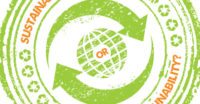While “sustainability” as a strategic initiative encompasses much more than packaging (social, economic and environmental factors must all be considered), packaging is the one touchpoint all consumers, value chain partners, investors and retailers will see.
And what they’re looking for isn’t a vague, greenwashed message about how great the packaging is for the environment. Here, the term “sustainable packaging” is really talking about an umbrella of packaging categories that can be tied to an unambiguous environmental benefit — lightweighting, recyclability, compostability and other specific ways to reduce the burden of your packaging on the environment.
Brands face immense pressure to step up their sustainability game:
- Major retailers like Target, Walmart and Kroger have imminent sustainability requirements for their suppliers.
- Investors have a heightened focus on the environmental, social and governance (ESG) measures of the companies in their portfolios.
- Customer scrutiny misses nothing.
Sustainable Label Design and Packaging: Benefits
Brand decisions lead back to the customer. 34% of baby boomers, 46% of Gen Xers and 75% of millennials “definitely or probably will change their purchase/consumption habits to reduce [their] impact on the environment,” according to research from Nielsen.
The trend here is obvious: customers care about sustainability and the younger the customer, the more they care. As time goes on, the purchasing power and, therefore, leverage of younger generations will only grow. Many large corporations are already implementing strategies to address this, foreshadowing that this trend could eventually affect midsized brands as well.
As the demand for sustainability picks up steam, some brands might still need to decide what exactly a retailer, investor or consumer observes as they pick up the product. Is the packaging and labels a seamless extension of its commitment to sustainability in all aspects of business, or are there disconnects between sustainability goals and how the product is packaged and labeled?
Not deciding is a decision in itself, as the label is the face of a brand in the marketplace and consumers are already beginning to stop picking up less-than-eco-friendly products.
Five obstacles brands face regarding sustainable packaging and labeling initiatives:
- Becoming overwhelmed by a variety of packaging options to choose from when trying to find something best suited for its sustainability goals
- Not considering further recyclable packaging options, such as labels, because a recyclable item, such as a bottle, is already in use
- Assuming sustainable label material will be too expensive and affect the price point
- Anticipating that switching materials could cause value chain and delivery disruptions.
- Thinking sustainable materials could hinder branding and be a tradeoff for product differentiation on the shelf
Sustainable Labels: Materials
In terms of sustainability, the real impact of the label focuses on things like responsible sourcing, recycle-friendly, compostable, lightweighted or recycled-content. The following subcategories can tell a very different stories about a brand and its label:
- Responsibly sourced materials are made from renewable resources and are often certified by an independent third party. For example, facestocks bearing the Forest Stewardship Council (FSC) stamp of approval would fall neatly under this category.
- Recycle-friendly label materials are engineered to support recycling of the associated container (bottle), and enable improved recovery and recycling through established recycling processes. Label material options have been created to ensure the label does not interfere with recycling of the bottle, and play a key role in ensuring that the quality of recycled plastics is maintained
- Compostable labels are designed to break down, along with all other components in your package, in an industrial composting facility. Availability and use of industrial composting and collection of compostable materials is in the early stages. In many cases composting is only available in selected areas, and specific requirements exist to ensure materials are properly composted.
- Lightweight or thin label materials are designed to use much less material than conventional labels. These materials promise a much smaller carbon footprint: Because thinner labels are lighter, less gas is consumed when shipping them. While label suppliers can adjust the lightness, brands should consider that labels withstand wear and tear during shipping and product use.
- Recycled label materials include some established minimum amount of post-consumer waste —consumer waste that is diverted from the landfill stream and recycled. Additionally, it doesn’t just have to be paper or plastic. Some specialized recycled label materials can be made from materials recovered from cotton, grapes, barley and other natural materials.
Brands can begin sustainable label initiatives by consulting with experts and packaging suppliers and considering which of the above benefits best aligns with its sustainability story, goals, product production and use. While compostable packaging development could have benefit down the road, a simple ‘first step’ to enhance package sustainability could instead be to shift to a lightweight label material, or consider a recycle-friendly solution — especially if customers don’t have access to curbside compost pickup, which could result in the compostable packages ending up in a landfill anyway.
Sustainable Labels: Recycling
When designing a package for recyclability, labels are often an afterthought. For example, the bottle and cap could be recyclable, but if the label isn’t compatible with the recycling process, then the packaging won’t get recycled. According to label materials supplier Avery Dennison, its “estimated that 560 million bottles are wasted in the recycling process every year, largely due to incompatible label materials.”
By narrowing in on labels, brands can find variety when it comes to recycle-friendly label materials. One such option would be film or paper labels with CleanFlake adhesive technology. Designed for use on PET containers, this strong adhesive stays firmly in place throughout the product lifecycle, and then fully separates from the PET surface (without leaving behind residue) during the recycling process.
How brands can get started
- Determine which benefits best align with sustainability story and goals
- Consult label experts and converters to determine which sustainable label materials would work best for the product and brand.
- Review the Federal Trade Commission’s (FTC) Green Guides. Examples on pages 5-12 of this document regard how the packaging design impacts what “green” marketing claims can and cannot be made.
- Check out the Association of Plastic Recyclers’ (APR) guide to plastics recyclability. Brands using a PET container can further consult the label material selection guide from the APR a read as well.
- Talk to How2Recycle about joining, complete the recyclability assessment and feature their recycling instructions on the label to gain more trust from consumers and ensure packages actually get recycled.
- Consider the packaging design holistically; if the rest of the package isn’t recyclable, choosing lightweight label material instead of a recycle-friendly label material might be a solution.
Sustainable Labels: Cost Breakdown
There’s no silver bullet sustainability solution where you both save the environment and cut your costs in every single situation. Sustainable label materials do, on occasion, cost more than their conventional counterparts do. That said, the value it provides in shelf pull, product differentiation and goodwill with consumers can, in some cases, far outweigh the incremental cost increase.
That said, savings can be realized on the total cost of the package in many situations. For example, lightweighting a product container could provide the cost savings that could in turn be used on a more sustainable label or cap. Savings in one area can help another.
But it’s important to remember that, regardless of the situation, consumers care deeply about packaging sustainability. Sixty percent of North American consumers are concerned with packaging waste, according to a Nielsen survey.
And consumers are increasingly taking that concern to the checkout counter:
- The Harvard Business Review says, “In more than 90% of CPG categories, sustainability-marketed products grew faster than their conventional counterparts.”
- According to Nielsen, “73% of consumers say they would definitely or probably change their consumption habits to reduce their impact on the environment.”
- “66% of global consumers say they’re willing to pay more for sustainable offerings … 73% of millennials are,” reports Nielsen in 2015. These trends were obvious five years ago, and are only becoming more prevalent over time.
Soon, sustainable packaging will no longer be a differentiator. It’ll simply be the price of entry. Brands should consider that not every sustainable packaging solution needs to be “game-changing” or “revolutionary.” And sustainability doesn’t have to break the bank. Simply switching to a responsibly sourced, FSC-certified material is a quick, plug-and-play way to enhance packaging sustainability. Brands can also ask label suppliers for suggestions on the smallest, low-cost are to begin with that would noticeably impact its label sustainability.
Sustainable Labels: Supply Chain
Many brands are concerned that switching materials will negatively impact their value chain. And understandably so — they’re under immense pressure to meet their retailer partners’ strict on-time delivery requirements.
To minimize the risk of your material switch, brands can determine the following when selecting new material:
- Materials that have worked well for similar size brands
- Examples of brands that have incorporated this material into its supply chain successfully
- Whether a stable supply chain has been established for particular sustainable raw materials
Sustainable Labels: Differentiation
With so many high-quality sustainable materials flooding the market each year, sustainability shouldn’t come at the expense of a brand’s vision. Including “sustainability” in the filters of this library of label materials from M_use, along with consulting a label printer, can help brands explore product-differentiating, sustainable label materials. Label converter can also help find similar materials that will perform well in brand’s product use environment.
Sustainable packaging is a complex topic — entire books have been written on the subject. Brands should consider these obstacles one by one and form actionable steps they can take today to switch to more sustainable labels.
For more information visit www.resourcelabel.com/capabilities/eco-friendly-sustainable-product-labels/.









